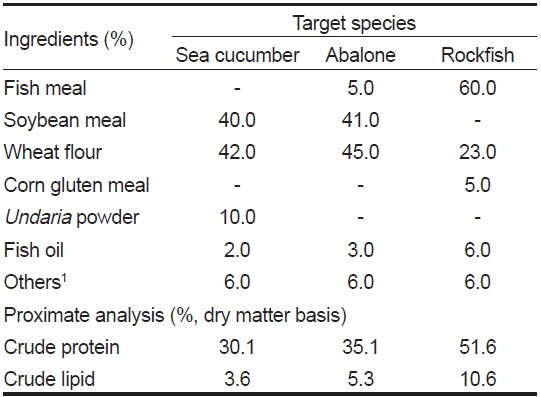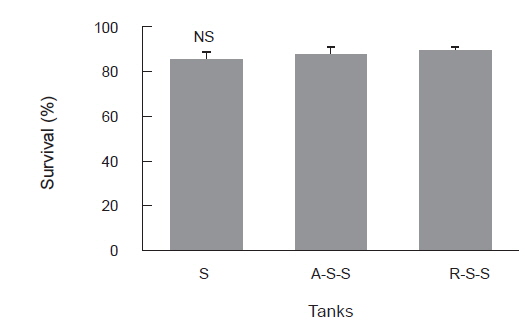



우리나라의 해산 어류 양식 산업은 넙치와 조피볼락 위주로 발전되어 왔다(Lee, 2002; Cho et al., 2006). 이들의 양식 생산량이 총 해산 양식 어류 생산량의 80% 전후를 차지하고 있기 때문에 소비자의 다양한 기호성에 대한 어종 제한, 판매시 가격 하락 등 여러 문제점이 잠재되어 있다(Kang et al., 1998). 패류의 경우, 굴이나 바지락 등이 양식되고 있지만, 이들 먹이는 자연에 의존하고 있다. 패류인 전복은 해상 가두리나 육상 수조에서 미역이나 배합사료를 공급하면서 양식하여 왔다(Lee, 2004). 하지만 양어가들은 전복을 양성하기 위해 배합사료보다 미역이나 다시마를 주로 공급하고 있어(Lee and Lee, 2004; Lee et al., 2004), 먹이로 사용되고 있는 해조류의 공급이나 가격 불안정 등의 문제점이 잠재되어 있다. 이러한 문제들을 해결하기 위해서는 부가 가치가 높은 양식 대상 어종 및 양식 기술 개발이 시급한 실정이다.
최근에 고부가 가치의 양식 대상종을 모색해 오던 양식업계에서는 기존 전복양식업에서 사용되는 종묘생산 및 양성 시설을 해삼 양식에 이용하는 시도가 있었다. 해삼은 한국, 중국, 일본 및 러시아 등에서 중요한 수산자원으로 자리 잡고 있으며, 국내에서는 물론 중국 및 일본에서도 비교적 고가로 유통되고 있다. 우리나라에서는 돌기해삼(
해삼은 박테리아, 원생생물 및 규조류 등의 동식물들에서 유래된 유기퇴적물들을 섭취하거나(Zhang et al., 1995), 다른 동물이 섭취하고 남은 부스러기나 배설물 등을 먹이로 섭취한다(Yang et al., 2000; Yang et al., 2001). 이처럼 모래나 펄에 함유된 유기물을 섭취하는 해삼의 먹이 습성을 고려해 보면, 해삼의 사료 섭취와 성장은 사육 system이나 환경에 따라서 달라질 가능성이 매우 높다. 따라서 이에 대한 연구를 수행하여 적합한 사육 환경과 사료 섭취에 대한 연구가 필요하다.
우리나라의 수산 양식은 고밀도 양식이 대부분이며, 해양수산부에서 육상 수조에서 배출되는 배출수나 가두리 양식장 주변 수질에 대해 감시를 하고 있지만, 양식장 주변의 수질 변화에 대한 우려는 여전히 남아 있다. 어류 양식장에서 나오는 분이나 섭취되지 못한 사료 찌꺼기가 수중으로 유실되면 수질 오염원이 증가되므로, 환경친화적인 양식 기술 개발에 대한 연구가 필요하다. 이러한 관점에서 볼 때, 복합양식은 어류 양식장 바닥에 오염원을 제거할 수 있어 양식장 주변 수질 개선에도 도움이 될 것으로 전망된다. 조피볼락 및 전복과 같은 주요 양식 어패류와 해삼의 복합양식 가능성이 제시될 수 있다면, 어류 양식장의 수질 개선 효과와 함께 해삼의 생산 단가를 낮출 수 있을 것으로 전망된다. 그래서 본 연구는 조피볼락 또는 전복을 해삼과 복합양식하였을 때의 효과를 성장 실험을 통하여 알아보고자 수행되었다.
해삼, 전복 및 조피볼락의 실험사료 조성을 Table 1에 나타내었다. 해삼 및 전복의 배합사료 제조는 펠렛 제조기로 압출 성형한 후, 실온에서 24시간 건조 후 사용하였다. 조피볼락 사료는 설계된 원료들을 분말형태로 잘 혼합하고 Extruder Pellet Mill (Kahl OEE 08 extruder, Germany)을 사용하여 EP를 제조하였다. 제조 조건으로 extruder 속도는 60 HZ, 압력은 75-80 bar, 사출구 온도는 80-90℃의 조건으로 하여 사료를 성형하였으며, 50℃의 열풍 건조기에서 건조 후 사용하였다. 이렇게 제조된 사료를 −30℃에 보관하면서 실험 수조에 공급하였다.

Ingredient and proximate composition of experimental diets for sea cucumber Apostichopus japonicus, abalone Haliotis discus hannai and rockfish Sebastes schlegeli
본 실험에 사용된 해삼은 전라남도 완도에서 종묘 생산된 어린 해삼을 구입한 후, 강릉원주대학교 해양생물연구교육센터로 수송하여 FRP 사각 수조(2 ton)에서 해삼용 상품사료를 2일 1회 공급하면서 2주간 적응시켰다. 해삼 단독 실험구(S)에는 외형적으로 건강한 어린 해삼(평균 체중: 1.2 g) 40마리, 해삼과 전복 복합 실험구(A-S-S)에는 해삼 40마리와 전복(평균 체중: 3 g) 15마리, 해삼과 조피볼락 복합 실험구(R-S-S)에는 해삼 40마리와 조피볼락(평균 체중: 6 g) 10마리를 각 실험구마다 3반복으로 각각의 사육 수조(50 L 사각수조)에 수용하였다. 사료 공급 방법은 다음과 같다. 해삼 단독 실험구(S)의 경우 해삼용 배합사료를 체중의 5%씩 2일 1회(17:00 h), 해삼과 전복 복합 실험구(A-S-S)의 경우 전복용 배합사료를 전복 체중의 5%씩 2일 1회(17:00 h), 해삼과 조피볼락 복합 실험구(R-S-S)의 경우 조피볼락용 배합사료를 1일 1회(17:00 h) 만복으로 공급하면서 12주간 사육하였다. 이때 복합사육 실험구의 해삼의 먹이는 별도로 공급하지 않았다. 사육실험 기간 동안 수온은 평균 15℃, 비중은 1.025이였으며, 각 수조마다 고압모래 여과해수를 1 L/min로 조절하여 흘려주었다.
실험 종료시에 각 실험수조에 생존한 해삼을 성분분석용으로 샘플하여 −75℃에 보관하였다. AOAC (1995)의 방법에 따라 조단백질(N×6.25)은 Auto Kjeldahl System (Buchi B-324/435/412, Switzerland)를 사용하여 분석하였고, 조지방은 ether를 사용하여 추출하였으며, 수분은 105℃의 dry oven에서 6시간 동안 건조 후 측정하였다. 회분은 600℃ 회화로에서 4시간 동안 태운 후 정량 하였다.
결과의 통계처리는 SPSS version 20.0 (SPSS Inc., Chicago, IL, USA)을 사용하였다. 측정치는 ANOVA-test를 실시 한 후, Duncan's multiple range test (Duncan, 1955)로 평균간의 유의성(
12주간 사육실험 종료 후, 해삼의 생존율을 Fig. 1에 나타내다. 모든 실험구간에서 80% 이상의 높은 생존율 값을 보이면서 유의한 차이를 보이지 않았다(
12주간의 사육한 해삼의 증중율을 Fig. 2에 나타내었다. 조피볼락과 복합양식한 R-S-S 실험구의 해삼 증중율이 가장 높은 값을 보였다. 복합양식한 R-S-S 실험구의 해삼 증중율은 해삼을 단독으로 수용한 S 실험구보다 유의적으로 높았으며 (

Proximate composition (%) of the whole body of juvenile sea cucumber Apostichopus japonicus fed the diets for 12 weeks1
본 연구에서 해삼 단독으로 사육하는 것보다 조피볼락과 함께 해삼을 복합양식하는 것이 더 높은 증체율을 보였는데, 이는 해삼의 먹이 습성 때문으로 판단된다. 해저의 모래나 암반에 있는 유기물이나 해조류를 섭취하는 해삼의 특성을 고려하여 보면, 어류가 배설한 분과 같은 부드러운 유기물이 해삼 먹으로서의 기능이 더 높다는 것을 알 수 있다(Hauksson, 1979; Michio et al., 2003; Ramofafia et al., 1997). 이러한 해삼의 서식 및 먹이 섭취 방법 때문에 다른 종들과 복합적으로 양식할 수 있는 가능성이 높을 것으로 판단되며, 패류인 전복과 복합양식에 대한 연구도 수행된바 있다(Kang et al., 2003). 본 연구에서도 전복과 해삼의 복합 실험구의 해삼 성장이 조피볼락과 해삼 복합 실험구의 해삼 성장과 유의한 차이 없이 양호한 결과를 보여 전복과의 복합양식 가능성도 있음을 암시하고 있다. 반면에 전복과 해삼의 복합 실험구의 해삼 성장이 해삼 단독 사육 실험구와 비교하여 유의차가 없는 것으로 나타나, 해삼은 전복과 같은 패류보다는 조피볼락과 같은 어류와 복합양식하는 것이 더 효율적일 것으로 판단된다. 이러한 복합양식 대상종에 따른 해삼의 성장 차이는 대상 동물의 서식 형태에 의한 것 때문으로 보인다. 전복의 경우는 해삼처럼 바닥에서 기어 다니기 때문에 서식 공간 경쟁이나 먹이 경쟁이 나타날 수 있는 반면에 유영하는 조피볼락과는 이러한 공간이나 먹이 경쟁이 없거나 적기 때문에 해삼 양식에는 전복보다는 조피볼락이 더 좋은 복합양식 대상종이 될 수 있을 것이다. 또한 전복용 배합사료보다 조피볼락용 배합사료의 단백질 등의 필수 영양소 함량이 높아 조피볼락의 배설물에 존재하는 영양소가 해삼 성장에 더 도움이 되었을 수도 있을 것이다.
복합양식의 효과는 다양한데, 섭취되지 않은 먹이나 배설된 분의 영양소를 재 이용하여 환경 오염원의 수중 배출을 감소시킬 수 있다. 양식장 주변의 수질오염은 양식 동물에 공급되는 사료에서 유래되는 것이 대부분이기 때문에 양식 동물에게 공급되는 사료의 품질과 사료 공급 방법이 매우 중요하다(Kim et al., 1998; Lee, 1998; Lee and Pham, 2010, 2011; Lee et al., 1999). 어패류가 섭취하지 못하고 남은 사료나 배설된 배설물은 수질오염원으로 작용할 수 있으므로, 조피볼락이나 전복과 같은 주요 양식 어패류와 해삼의 복합양식 가능성을 제시할 수 있다면, 어류 양식장의 수질 개선 효과와 함께 해삼의 생산 단가를 낮출 수 있어 보다 효율적인 해삼 양식이 가능할 수 있을 것이다. Kang et al. (2003)의 연구에서도 복합양식 실험구 수조의 암모니아 농도가 대조구보다 낮음을 확인하였다. 그리고 동일한 사육 공간을 두 종이 동시에 사용함으로써 경제적인 사육 시스템이 될 수 있을 것이다 (Mou et al., 2000; Kang et al., 2003; Michio et al., 2003; Pitt et al., 2004; Zhou et al., 2006).
이상의 결과에서, 다른 어종과 해삼의 복합양식은 여러 면에서 긍정적인 정보들을 제공할 수 있을 것으로 판단된다. 특히, 본 연구의 해삼은 전복보다는 조피볼락과의 복합양식이 더 유리한 것으로 나타났다. 복합양식은 제한된 공간에서 두 어종을 동시에 생산할 수 있을 뿐만 아니라 유실되는 사료 및 배설물을 이용한다는 환경친화적인 면에서 매우 긍정적으로 검토 되어야 할 것이다. 다양한 어종과의 복합양식, 방양 밀도 등에 대한 연구가 지속된다면 양식장을 보다 입체적으로 사용하고 어민의 소득을 향상 시킬 것으로 전망된다.



